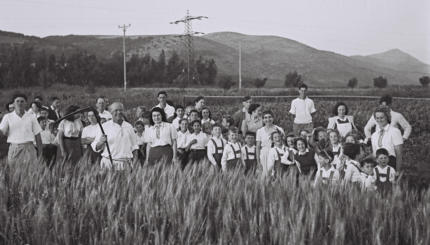Last year I rediscovered Megillat Ruth. On the morning of the second day of Shavuot I joined a closely knit group of friends and family gathered for shacharit, morning services, at the home of the Weiniger family to celebrate Lucy’s Bat Mitzvah. It was a standard Orthodox service enhanced by the intimacy of the space and everyone’s participation in the melodious tunes. When it was time for the customary reading of Megillat Ruth, Lucy stood at the bima, podium, which, in line with the mechitza, was between the women’s and men’s sections. She leyned Megillat Ruth from a klaf, a handwritten parchment scroll, chanting the words in the traditional tune.
Her words rang out with passion and enthusiasm, and suddenly, as she intoned Naomi’s words: “No, my daughters, for it is much more bitter for me than for you, for the hand of the Lord has gone forth against me,” entreating her daughters-in-law to return to their mothers’ homes, I too felt a lump in my throat. As she continued: “They raised their voices and wept again; and Orpah kissed her mother-in-law, but Ruth cleaved to her,” I had tears in my eyes.
I have heard and studied Megillat Ruth many times. It is a biblical narrative unusually populated with female characters. Ruth and Naomi’s beautiful and moving story resonates with women in particular, because it speaks of the bond of female friendship, of experiencing bereavement as a mother and as a wife, of being childless, of loneliness and vulnerability in being homeless. It is a story that easily engenders cognitive empathy. But this reading was different. I heard it in a completely new voice. It was more than the fact that it was chanted by a Bat Mitzvah girl to mark her own commitment to Jewish faith and Jewish community.
Hearing the narrative read by a female voice engendered affective empathy. It elicited in me, and those around me, emotions and feelings mirroring those experienced by the characters. Experiencing first the grief, longing and despair, then joy and relief with Ruth and Naomi as their story unfolded made the story particularly compelling.
This Megillat Ruth experience inspired me to encourage more women to engage with the story of Ruth in preparation for Shavuot and to encourage opportunities for women’s leyning of Ruth on Shavuot itself. The main focus of Shavuot is generally the Tikkun Leil, all night study session, which is not always easily accessible to women. We are often rather washed out by the second day of Yom Tov, and so Megillat Ruth often doesn’t get the attention it deserves.
I invite you to change this and rediscover Megillat Ruth. Whether through traditional text study or through the ritual of leyning on Shavuot. It is possibly the most accessible of the five megillot; rich with themes for discussion and a great entry point for women to explore a new ritual by learning to leyn.
To facilitate this JOFA has created a set of resources. After Shavuot, we asked Lucy to record her leyning in the hope it will inspire others. You can find it all at jofa.org/megillat-ruth-book-club
Shavuot
Pronounced: shah-voo-OTE (oo as in boot), also shah-VOO-us, Origin: Hebrew, the holiday celebrating the giving of the Torah at Mount Sinai, falls in the Hebrew month Sivan, which usually coincides with May or June.



